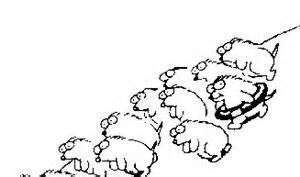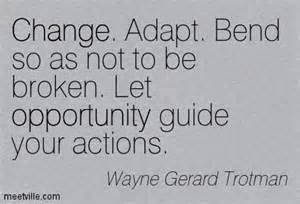Having an outlet for emotions, especially negative emotions, was the focus of last week’s post. Since change makes something different, we often have an emotional response to the change: surprise, indifference; hope, fear; happiness, sadness; gratitude, anger; joy, grief; relief, frustration; love, hate. While our reaction to change should be based on logic, in reality, our first reaction is usually an emotional one. Oftentimes one’s refusal to change or accept the change is because of an emotional attachment to what was; to the past.

So, this week, I want to explore the importance of adapting in times of change. Simply put, to adapt is to change to fit a new environment or different conditions. Actor and martial artist Bruce Lee said, “Empty your mind. Be formless. Shapeless. Like water. You put water into a cup, it becomes the cup. You put water into a bottle, it becomes the bottle. You put water into a teapot, it becomes the teapot. Water can flow or it can crash. Be water, my friend.”

What Lee is emphasizing here is the flexibility, the adaptability of water. Water has no set form or shape; it conforms to, it adapts to whatever container it is put in. This is a perfect example for a life skill we should all strive for: the ability to adapt to change. Along with adaptability comes flexibility. Flexibility means you avoid rigidity. Think of our ancestors. They had to adapt to new conditions. They faced perils from nature, disease, constant threats of attacks and more. Yet, they survived due to their ability to embrace flexibility and adaptability. As Charles Darwin says, “It is not the strongest of the species that survives, nor the most intelligent that survives. It is the one that is most adaptable to change.”
Being able to adapt is difficult for most humans, and the reason for this is because humans are creatures of habit; having to change our patterns and behaviors is frustrating and annoying. We would really simply prefer to keep doing things the old way, since this allows us to stay in our comfort zone. And, while we may feel safe and secure in our comfort zone, in the long run, this may not be what is best for us. There are times when we must accept what is, let go of what was, and have faith in what will be. Never forget, just when the caterpillar thought the world was over, it became a butterfly!

Doe Zantamata”s philosophy is, “If you were to open the front door and see that it had started raining, you wouldn’t slam it and curse the clouds because it was sunny just an hour before. You’d get an umbrella, and be on your way. Part of embracing change in life, is knowing that you will be able to adapt. There is a comfort in the familiar, but new things can be better than before, or, the change may even only be temporary. When faced with change that’s not in your control, adapt, and be on your way.”
One of the things we all have in common, no matter what stage of life we’re at, is change; it is always constant. Children have to adjust to new schools and teachers, teenagers and young adults must adapt to college and first loves, adults must learn how to deal with marriage and careers, and older folks must acclimate to empty nests and retirement. No matter our age, we all have to cope with things like death, sickness, coming and going of people, changing seasons, and other unavoidable evolutions. Adapting to changes in life is a skill we all must learn. So, how can you adapt to change?
Think differently. Albert Einstein said, “We can’t solve problems by using the same kind of thinking we used when we created them.” Dealing with the unexpected is one of the most difficult things anyone can face. The unexpected moves us out of our comfort zone before we realize what is happening. When faced with the unforeseen, traditional or logical thinking may not provide us with the best option to deal with the situation. We may be better served thinking creatively or divergently.
Divergent thinking means walking to the beat of a different drummer. Following the crowd isn’t always the best strategy when dealing with change. The best visual for this is a cartoon where a group of lemmings is running toward a body of water and to certain death, except for one lemming who has an inner tube wrapped around him. He can be viewed as a divergent thinker; one who assessed the situation and came up with a unique solution to his predicament.

Practice kaleidoscopic thinking. Albert Einstein also said, “The definition of insanity is doing the same thing over and over and expecting different results. When faced with change and transition that present major differences, what worked in the old may not work in the new. In a changed environment, when we start “getting down on ourselves” because things just aren’t working out, they may not be working out because we are doing what Anthony Robbins indicates, “If you do what you’ve always done, you’ll get what you’ve always gotten.”
Rosabeth Moss Kanter’s kaleidoscopic thinking provides a wonderful model for a new style of thinking; for thinking and approaching decision making differently especially when adapting to change. She says, “Creativity is a lot like looking at the world through a kaleidoscope. You look at a set of elements, the same ones everyone else sees, but then reassemble those floating bits and pieces into an enticing new possibility. The notion of forming new patterns from existing information or resources is so simple, yet something we might not normally consider doing.

Think outside the box. To think outside the box, outside the traditional, forces us to look at common things and see something different or use a different mindset to solve issues facing us in the changed environment. And, when we think in this manner, we are thinking in an “adapted” way. When we think in this way, we are being innovative, giving us a way of thinking that questions and challenges prevailing thought and opens us up to numerous solutions rather than just the way something has always been done. Innovativeness permits us to exceed our own expectations. When we are innovative, we are creative. When we are creative, we think “outside the box;” we use our imagination. Thinking or acting in an innovative way and with a purpose may be just what it takes to propel us through the change and its transitions to a new beginning.

Be resourceful and innovative. Resourcefulness is about optimizing what you have to work with. Innovation is not just about creating something new; it also applies to making old things work better. Using one’s imagination can help make adaptations when necessary. Imagination makes it possible to experience a whole world inside the mind. It gives the ability to look at any situation from a different point of view, and enables one to mentally explore the past and the future. Imagination is a creative power that is necessary for dealing with change.
Remove the negative options. If something bad happens, your subconscious mind searches for the available questions and answers. You need to remove such negative options of getting disappointed or becoming depressed, if the change isn’t as you wanted it to be.
Maya Angelou says, “If you don’t like something, change it. If you can’t change it, change your attitude.” Remove negative thoughts and doubts, be optimistic, and you will find that you are able to adapt to the changes in your life more easily.

Change the way you approach the situation. Confucius says, “When it is obvious that the goals cannot be reached, don’t adjust the goals, adjust the action steps.” When the changed situation overwhelms you, avoid feeling bad. Rather, try to change the way you approach the situation. Try to work harder, study more, be flexible, think from a new angle, and start all over again.
Let’s remember Bruce Lee’s advice, “Empty your mind. Be formless. Shapeless. Like water. You put water into a cup, it becomes the cup. You put water into a bottle, it becomes the bottle. You put water into a teapot, it becomes the teapot. Water can flow or it can crash. Be water, my friend.” Try being as adaptable as water the next time you are faced with a change. You may just find it a lot easier to manage and negotiate whatever the change is presenting you.

